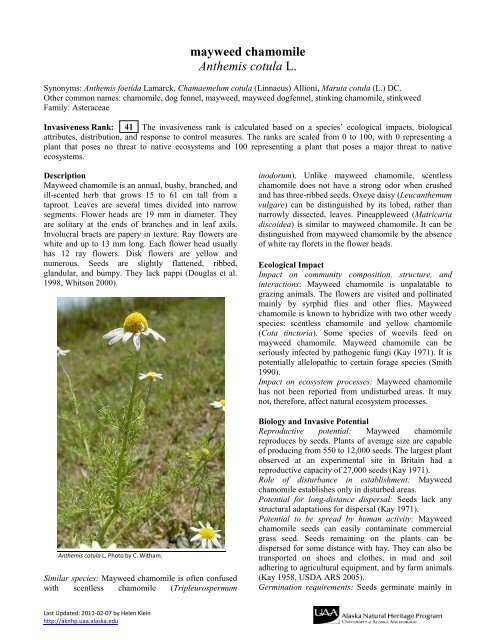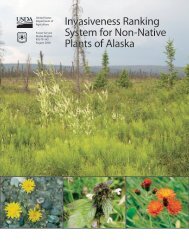mayweed chamomile Anthemis cotula L. - Alaska Natural Heritage ...
mayweed chamomile Anthemis cotula L. - Alaska Natural Heritage ...
mayweed chamomile Anthemis cotula L. - Alaska Natural Heritage ...
You also want an ePaper? Increase the reach of your titles
YUMPU automatically turns print PDFs into web optimized ePapers that Google loves.
<strong>mayweed</strong> <strong>chamomile</strong><strong>Anthemis</strong> <strong>cotula</strong> L.Synonyms: <strong>Anthemis</strong> foetida Lamarck, Chamaemelum <strong>cotula</strong> (Linnaeus) Allioni, Maruta <strong>cotula</strong> (L.) DC.Other common names: <strong>chamomile</strong>, dog fennel, <strong>mayweed</strong>, <strong>mayweed</strong> dogfennel, stinking <strong>chamomile</strong>, stinkweedFamily: AsteraceaeInvasiveness Rank: 41 The invasiveness rank is calculated based on a species’ ecological impacts, biologicalattributes, distribution, and response to control measures. The ranks are scaled from 0 to 100, with 0 representing aplant that poses no threat to native ecosystems and 100 representing a plant that poses a major threat to nativeecosystems.DescriptionMayweed <strong>chamomile</strong> is an annual, bushy, branched, andill-scented herb that grows 15 to 61 cm tall from ataproot. Leaves are several times divided into narrowsegments. Flower heads are 19 mm in diameter. Theyare solitary at the ends of branches and in leaf axils.Involucral bracts are papery in texture. Ray flowers arewhite and up to 13 mm long. Each flower head usuallyhas 12 ray flowers. Disk flowers are yellow andnumerous. Seeds are slightly flattened, ribbed,glandular, and bumpy. They lack pappi (Douglas et al.1998, Whitson 2000).<strong>Anthemis</strong> <strong>cotula</strong> L. Photo by C. Witham.Similar species: Mayweed <strong>chamomile</strong> is often confusedwith scentless <strong>chamomile</strong> (Tripleurospermuminodorum). Unlike <strong>mayweed</strong> <strong>chamomile</strong>, scentless<strong>chamomile</strong> does not have a strong odor when crushedand has three-ribbed seeds. Oxeye daisy (Leucanthemumvulgare) can be distinguished by its lobed, rather thannarrowly dissected, leaves. Pineappleweed (Matricariadiscoidea) is similar to <strong>mayweed</strong> <strong>chamomile</strong>. It can bedistinguished from <strong>mayweed</strong> <strong>chamomile</strong> by the absenceof white ray florets in the flower heads.Ecological ImpactImpact on community composition, structure, andinteractions: Mayweed <strong>chamomile</strong> is unpalatable tograzing animals. The flowers are visited and pollinatedmainly by syrphid flies and other flies. Mayweed<strong>chamomile</strong> is known to hybridize with two other weedyspecies: scentless <strong>chamomile</strong> and yellow <strong>chamomile</strong>(Cota tinctoria). Some species of weevils feed on<strong>mayweed</strong> <strong>chamomile</strong>. Mayweed <strong>chamomile</strong> can beseriously infected by pathogenic fungi (Kay 1971). It ispotentially allelopathic to certain forage species (Smith1990).Impact on ecosystem processes: Mayweed <strong>chamomile</strong>has not been reported from undisturbed areas. It maynot, therefore, affect natural ecosystem processes.Biology and Invasive PotentialReproductive potential: Mayweed <strong>chamomile</strong>reproduces by seeds. Plants of average size are capableof producing from 550 to 12,000 seeds. The largest plantobserved at an experimental site in Britain had areproductive capacity of 27,000 seeds (Kay 1971).Role of disturbance in establishment: Mayweed<strong>chamomile</strong> establishes only in disturbed areas.Potential for long-distance dispersal: Seeds lack anystructural adaptations for dispersal (Kay 1971).Potential to be spread by human activity: Mayweed<strong>chamomile</strong> seeds can easily contaminate commercialgrass seed. Seeds remaining on the plants can bedispersed for some distance with hay. They can also betransported on shoes and clothes, in mud and soiladhering to agricultural equipment, and by farm animals(Kay 1958, USDA ARS 2005).Germination requirements: Seeds germinate mainly inLast Updated: 2011-02-07 by Helen Kleinhttp://aknhp.uaa.alaska.edu
autumn and spring, but some germination occursthroughout the year (Kay 1971, Roberts and Neilson1981). The best emergences were obtained duringoutdoor experiments with temperatures alternatingbetween 20°C and 30°C in the presence of light (Kay1971, Gealy et al. 1994). High soil water content isrequired for successful germination and seedlingestablishment (Gealy et al. 1985).Growth requirements: Mayweed <strong>chamomile</strong> is primarilyadapted to relatively dry climates and warm summers. Itgrows best in areas that have a July mean temperaturegreater than 15°C and a mean annual precipitation lessthan 89 cm. This species grows most frequently in heavyclay and clay-loam soils, both calcareous and neutral. Italso grows in poorly drained, medium-textured soils. Itis not well adapted to growing in light sand. Mayweed<strong>chamomile</strong> is frost-hardy at the rosette stage and cangrow as a winter annual. It is moderately droughtresistant.Summer droughts restrict the size of the plant,but they do not prevent the setting of seed (Kay 1971).Congeneric weeds: Corn <strong>chamomile</strong> (<strong>Anthemis</strong>arvensis) is considered a noxious weed in Colorado(USDA 2006, Invaders 2010)Legal ListingsHas not been declared noxiousListed noxious in <strong>Alaska</strong>Listed noxious by other states (CO, NV)Federal noxious weedListed noxious in Canada or other countriesDistribution and abundanceMayweed <strong>chamomile</strong> is commonly found in cerealcrops, waste areas, farmyards, overgrazed pastures, androadsides (Hultén 1968, Kay 1971, Roberts and Neilson1981, Whitson et al. 2000).Native and current distribution: Mayweed <strong>chamomile</strong> isnative to the Mediterranean region but has been widelyintroduced as a weed in the temperate zone. ItsEuropean distribution extends to southern Norway,central Sweden, and southern Finland. Its southernextent includes the Canary Islands, Egypt, and westernAsia. This species has been introduced to the UnitedStates, Canada, Argentina, Australia, and New Zealand(Hultén 1968, Kay 1957, USDA ARS 2005). Mayweed<strong>chamomile</strong> has been documented from the PacificMaritime and Interior-Boreal ecogeographic regions of<strong>Alaska</strong> (Hultén 1968, Welsh 1974, AKEPIC 2010,UAM 2010).Pacific MaritimeInterior- BorealArctic-AlpineCollection SiteDistribution of <strong>mayweed</strong> <strong>chamomile</strong> in <strong>Alaska</strong>ManagementCombinations of rotational grazing and herbicidetreatments are the best methods for successful control of<strong>mayweed</strong> <strong>chamomile</strong> in crops and pastures (Ivens 1979).This species is resistant to a number of herbicides.References:AKEPIC database. <strong>Alaska</strong> Exotic Plant InformationClearinghouse Database. 2010. Available:http://akweeds.uaa.alaska.edu/Douglas, G. W., G. B. Straley, D. Meidinger, J. Pojar.1998. Illustrated flora of British Columbia. V.2. Ministry of Environment, Lands and ParksMinistry of Forests. British Columbia 401 pp.Gealy, D.R., F.L. Young, and L.A. Morrow. 1985.Germination of <strong>mayweed</strong> (<strong>Anthemis</strong> <strong>cotula</strong>)achenes and seed. Weed Science 33: 69-73.Gealy, D.R., S.A. Squier, and A.G. Ogg Jr. 1994. Soilenvironment and temperature affectgermination and seedling growth of <strong>mayweed</strong><strong>chamomile</strong> (<strong>Anthemis</strong> <strong>cotula</strong>). WeedTechnology 8: 668-672.Hultén, E. 1968. Flora of <strong>Alaska</strong> and NeighboringTerritories. Stanford University Press, Stanford,CA. 1008 p.Invaders Database System. 2010. University ofMontana. Missoula, MT.http://invader.dbs.umt.edu/Kay, Q.O.N. 1971. Biological flora of the British Isles.<strong>Anthemis</strong> <strong>cotula</strong> L. The Journal of Ecology59(2): 623-636.Roberts, H.A. and J.E. Neilson. 1981. Seed survival andperiodicity of seedling emergence in twelveweedy species of Compositae. Annals ofApplied Biology 97: 325-334.Smith, A.E. 1990. Potential allelopathic influence ofcertain pasture weeds. Crop protection 9(6):410-414.UAM. 2010. University of <strong>Alaska</strong> Museum, Universityof <strong>Alaska</strong> Fairbanks. Available:http://arctos.database.museum/home.cfmUSDA, ARS, National Genetic Resources Program.Germplasm Resources Information Network -(GRIN) [Online Database]. NationalGermplasm Resources Laboratory, Beltsville,Last Updated: 2011-02-07 by Helen Kleinhttp://aknhp.uaa.alaska.edu
Maryland. URL:http://www.arsgrin.gov/var/apache/cgibin/npgs/html/taxon.pl?300618 [March 8,2005].USDA, NRCS. 2006. The PLANTS Database, Version3.5 (http://plants.usda.gov). Data compiledfrom various sources by Mark W. Skinner.National Plant Data Center, Baton Rouge, LA70874-4490 USA.Welsh, S. L. 1974. Anderson’s flora of <strong>Alaska</strong> andadjacent parts of Canada. Brigham UniversityPress. 724 pp.Whitson, T. D., L. C. Burrill, S. A. Dewey, D. W.Cudney, B. E. Nelson, R. D. Lee, R. Parker.2000. Weeds of the West. The Western Societyof Weed Science in cooperation with theWestern United States Land Grant Universities,Cooperative Extension Services. University ofWyoming. Laramie, Wyoming. 630 pp.Last Updated: 2011-02-07 by Helen Kleinhttp://aknhp.uaa.alaska.edu
















